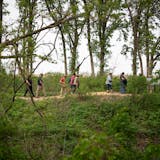On any given day, an estimated nearly 400 Hennepin County young people don't have stable, permanent places to stay. But a recent collaborative effort to house and employ local homeless youth made serious headway toward turning that statistic around.
During a 100-day challenge that ended Nov. 8, a coalition of 30 public, private and nonprofit groups set the ambitious goal of moving 150 young people from homelessness to more stable situations. But they exceeded their benchmark by finding housing and/or employment for 236 local teens and young adults.
The county's success moves the region and state closer toward preventing and ending homelessness altogether. And it demonstrates the power of well-coordinated, focused public-private partnerships.
Last summer, Hennepin County and four cities (Baltimore; Columbus, Ohio; Louisville, Ky.; and Palm Beach, Fla.) were selected for the challenge by the U.S. Department of Housing and Urban Development (HUD). The charge was to find housing for homeless young people, ages 16-24, in just over three months. HUD provided training and technical assistance to the Hennepin County team, but no direct funding. The progress occurred largely using existing resources from the organizations involved.
More than 35 percent of the local young people involved were reunited with family members. And for those who needed to work, the coalition matched them with job training, work readiness, and other educational programs, jobs and paid internships.
David Hewitt, director of the Hennepin County and Minneapolis Office to End Homelessness, said that HUD and the Rapid Response Institute provided a methodology for expediting results and ongoing mentoring for the local team. He said the groups involved included nonprofits; city, county and state representatives; members of the business and law enforcement communities; and front-line advocates. The initiative also included formerly homeless young people.
Hewitt said the county's application for the federal challenge was the only one to focus on employment. "Youth want and need housing ... and jobs,'' he said. That's one of the most valuable things we've learned — we have to bring both of those worlds to homeless youth.''
He added that the challenge participants also learned how crucial family reunification could be for younger teens. Helping them establish caring, supportive connections to immediate or extended families can make a world of difference.
![Three weeks ago, Octavio Rodriguez switched from making transmission parts to casting parts for hospital bed brake assemblies at Twin City Die Castings. ] GLEN STUBBE • glen.stubbe@startribune.com Thursday, April 9, 2020 How employee-owned Twin City Die Casting, which just laid off 40 production workers of its 250 employees in what was supposed to be a good year, is trying to accelerate its pivot to growing medical parts business for ventilators, hospital beds, etc as it copes with instan](https://arc.stimg.co/startribunemedia/WNZYKGTZ5IYMUCO3KI5TR3N7WI.jpg?&w=80&ar=1:1&fit=crop)
djoles@startribune.com As boaters flock to Minnesota lakes and rivers this holiday weekend for the unofficial kick-off to the boating season, they'll face more inspections in and out of the water as local cities and counties ramp up their work to stop the spread of invasive species. Across the metro, more boat accesses will be staffed by watercraft inspectors thanks to $10 million funneled to county government programs this year, up from $4.5 million the state allocated last year. ORG XMIT: MIN1505222156290209 ORG XMIT: MIN1506021218440580](https://arc.stimg.co/startribunemedia/34QSKO44B2XKVNUZCO5SLJQSLY.jpg?&w=80&ar=1:1&fit=crop)

